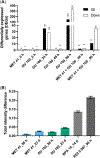Effects of Metformin and its Metabolite Guanylurea on Fathead Minnow (Pimephales promelas) Reproduction
- PMID: 35920346
- PMCID: PMC10634263
- DOI: 10.1002/etc.5450
Effects of Metformin and its Metabolite Guanylurea on Fathead Minnow (Pimephales promelas) Reproduction
Abstract
Metformin, along with its biotransformation product guanylurea, is commonly observed in municipal wastewaters and subsequent surface waters. Previous studies in fish have identified metformin as a potential endocrine-active compound, but there are inconsistencies with regard to its effects. To further investigate the potential reproductive toxicity of metformin and guanylurea to fish, a series of experiments was performed with adult fathead minnows (Pimephales promelas). First, explants of fathead minnow ovary tissue were exposed to 0.001-100 µM metformin or guanylurea to investigate whether the compounds could directly perturb steroidogenesis. Second, spawning pairs of fathead minnows were exposed to metformin (0.41, 4.1, and 41 µg/L) or guanylurea (1.0, 10, and 100 µg/L) for 23 days to assess impacts on reproduction. Lastly, male fathead minnows were exposed to 41 µg/L metformin, 100 µg/L guanylurea, or a mixture of both compounds, with samples collected over a 96-h time course to investigate potential impacts to the hepatic transcriptome or metabolome. Neither metformin nor guanylurea affected steroid production by ovary tissue exposed ex vivo. In the 23 days of exposure, neither compound significantly impacted transcription of endocrine-related genes in male liver or gonad, circulating steroid concentrations in either sex, or fecundity of spawning pairs. In the 96-h time course, 100 µg guanylurea/L elicited more differentially expressed genes than 41 µg metformin/L and showed the greatest impacts at 96 h. Hepatic transcriptome and metabolome changes were chemical- and time-dependent, with the largest impact on the metabolome observed at 23 days of exposure to 100 µg guanylurea/L. Overall, metformin and guanylurea did not elicit effects consistent with reproductive toxicity in adult fathead minnows at environmentally relevant concentrations. Environ Toxicol Chem 2022;41:2708-2720. © 2022 SETAC. This article has been contributed to by U.S. Government employees and their work is in the public domain in the USA.
Keywords: Aquatic toxicology; contaminants of emerging concern; endocrine-disrupting compounds; reproductive toxicity.
© 2022 SETAC. This article has been contributed to by U.S. Government employees and their work is in the public domain in the USA.
Figures



Similar articles
-
Effects of the antimicrobial contaminant triclocarban, and co-exposure with the androgen 17β-trenbolone, on reproductive function and ovarian transcriptome of the fathead minnow (Pimephales promelas).Environ Toxicol Chem. 2017 Jan;36(1):231-242. doi: 10.1002/etc.3531. Epub 2016 Jul 29. Environ Toxicol Chem. 2017. PMID: 27312088 Free PMC article.
-
Sensitivity and Accumulation of Perfluorooctanesulfonate and Perfluorohexanesulfonic Acid in Fathead Minnows (Pimephales promelas) Exposed over Critical Life Stages of Reproduction and Development.Environ Toxicol Chem. 2021 Mar;40(3):811-819. doi: 10.1002/etc.4936. Epub 2021 Jan 29. Environ Toxicol Chem. 2021. PMID: 33275288
-
Life-cycle exposure of fathead minnows to environmentally relevant concentrations of the β-blocker drug propranolol.Environ Toxicol Chem. 2017 Jun;36(6):1644-1651. doi: 10.1002/etc.3703. Epub 2017 Jan 11. Environ Toxicol Chem. 2017. PMID: 27925269
-
Metformin exposure at environmentally relevant concentrations causes potential endocrine disruption in adult male fish.Environ Toxicol Chem. 2015 Feb;34(2):291-6. doi: 10.1002/etc.2793. Epub 2014 Dec 31. Environ Toxicol Chem. 2015. PMID: 25358780 Free PMC article.
-
Current research and guidelines for euthanasia in laboratory fish with a focus on fathead minnows.Lab Anim. 2025 Jun;59(3):319-331. doi: 10.1177/00236772241288146. Epub 2025 Jan 25. Lab Anim. 2025. PMID: 39862184 Free PMC article. Review.
Cited by
-
Assessing the pharmaceutical residues as hotspots of the main rivers of Catalonia, Spain.Environ Sci Pollut Res Int. 2024 Jul;31(31):44080-44095. doi: 10.1007/s11356-024-33967-7. Epub 2024 Jun 26. Environ Sci Pollut Res Int. 2024. PMID: 38926308 Free PMC article. Review.
References
-
- Ankley GT, Cavallin JE, Durhan EJ, Jensen KM, Kahl MD, Makynen EA, Thomas LM, Wehmas LC, & Villeneuve DL (2012). A time-course analysis of effects of the steroidogenesis inhibitor ketoconazole on components of the hypothalamic-pituitary-gonadal axis of fathead minnows. Aquatic Toxicology, 114–115, 88–95. 10.1016/j.aquatox.2012.02.012 - DOI - PubMed
-
- Blackwell BR, & Ankley GT (2021). Simultaneous determination of a suite of endogenous steroids by LC-APPI-MS: Application to the identification of endocrine disruptors in aquatic toxicology. Journal of Chromatography. B, Analytical Technologies in the Biomedical and Life Sciences, 1163, 122513. 10.1016/j.jchromb.2020.122513 - DOI - PMC - PubMed
Publication types
MeSH terms
Substances
Grants and funding
LinkOut - more resources
Full Text Sources
Molecular Biology Databases

